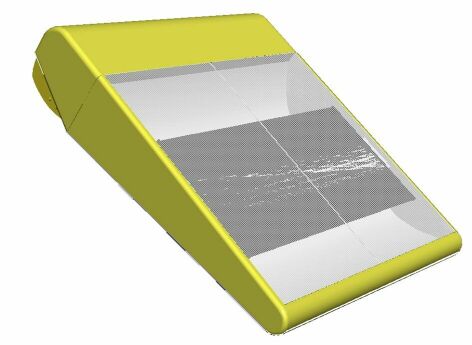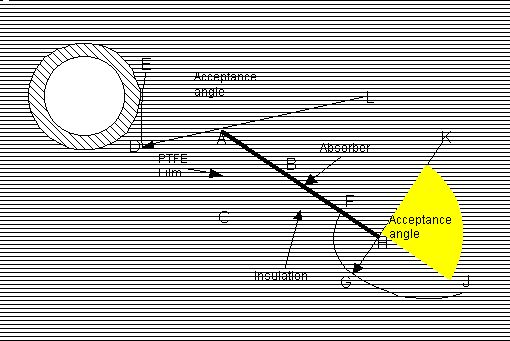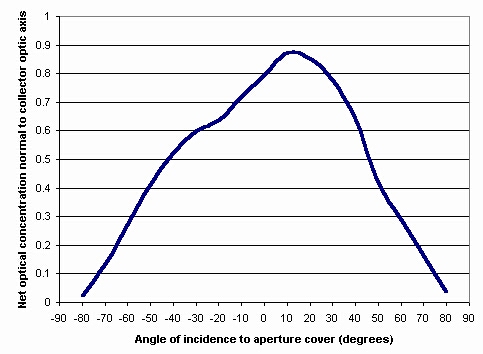 |
The Solar Energy Group @ |
| Home Contact |
|
|
Research @ the Solar Energy GroupAdvanced design of domestic hot water heatingThis work is in collaboration with Prof Graham Morrison of the School of Mechanical and Manufacturing Engineering University of New South Wales. Current solar water heaters overproduce slightly in summer and have poor performance in winter at the time of maximum load. They use an expensive absorber plate over the entire absorbing aperture of the collector and fail to use the backside of the absorber. They often have under insulated tanks and are not optimised as integrated systems. A design approach is described here to use existing commercial flat plat absorber and tank components in a new way to maximise solar contribution and minimise material usage in the construction of the system. The design criterion used is not maximum peak efficiency, but minimum annual backup energy supplied to the system to meet an annual load. This corresponds to meeting a minimum greenhouse emissions requirement in both invested pollution during manufacture and pollution from backup energy supplied. Two new designs were developed which allow the solar fraction of systems to rise to approximately 80-90% in Sydney using a standard model of family usage specified in Australian Standard AS4234. Pollution from fuel use drops to as little as 40% of that of conventional solar systems. These new designs use one absorber plate instead of two and a lighter tank. Comparisons of solar fraction are offered for a range of international sites. An important insight is that with such a performance optimised system, the ultimate solar fraction is limited by long duration cloud cover at the site of installation and making the system larger only increases dumped energy, not utilisable energy. Technical efficiency improvements only reduce system area. Solar radiation is distributed on both sides of the plate to reduce material usage. In addressing the depth of the panel required to fit the reflector under the absorber plate it became clear that, in a conventional flat plate thermosyphon system with an external horizontal tank, the major perceived bulk of the system on the roof is the tank, not the panels. Hence, if the new panel system could hide the tank from view, the overall appearance might be improved rather than degraded. The maximum bulk that was acceptable appeared to be a system as schematically illustrated in Figure 1, where the collector cover slopes down from the top of the horizontal tank nearly to a point, providing a slender triangular cross-section to the eye from the side, and a unified black appearance from the front. The single absorber plate is arranged to be just below the transparent cover in a location which allows space for the reflectors to introduce solar radiation to the underside of the panel. The position chosen was achieved by numerical optimisation based upon minimum backup energy supplied to the system on an annual basis using a model based upon the typical usage of a family of four in Sydney. The design of the reflectors was based upon standard non-imaging curvature formation techniques, but angles of acceptance were chosen by numerical optimisation (See Fig. 2). In order to maximise available aperture, the plate had to be positioned away from the top and bottom edges of the aperture and reflectors were needed at both the top and bottom ends. The bottom reflector is designed in a similar manner, with a circular section FG and a parabolic section GJ centred on point H with optic axis aimed approximately at the equinox solar position KH. The exact angle of this optic axis and the extension distance of HJ are variables, which were refined during numerical optimisation. A winter bias is needed but the seasonal bias solutions contained in Rabl (1976), Mills and Guitronich (1978), Mills and Guitronich, (1979), and Mills, Monger and Morrison (1994) all rely upon the inclination of the collector aperture toward the solstice which is intended to be emphasised in performance. However, in a slim-line design this is difficult to achieve for the case of winter bias, where the aperture should point toward the low winter sun. The approach in this design is to use the front reflector section as a seasonally variable optical element, which the total acceptance angle is approximately 90° as shown in Fig. 2. For a 25° roof in Sydney the collector aperture as defined by the cover glass points approximately to the equinox position and would not deliver seasonal bias if a conventional receiver were underneath. However, the front reflector section only operates during the months on the winter side of equinox. This reflector provides the necessary asymmetry and reduces dumped energy in the summer months. Figure 3 shows optical collection as a function of incident ray angle. The increased collection in winter deviating from the standard cosine response is due to the front reflector. Table 1 summarises the performance of these systems as modelled for Sydney, and this is compared to a conventional two panel thermosyphon system. It is clear that comparatively low levels of backup energy and pollution are achievable. References:Mills D.R. and Giutronich J.E. (1978), Ideal prism solar concentrators, Solar Energy 21, 423-430. Mills D.R. and Giutronich J.E. (1979), Symmetrical and assymetrical ideal cylindrical radiation transformers and concentrators, J. Optical Society of America 69 (2), 325-328. Mills D.R., Monger A., and Morrison G.L. (1994), Comparison of fixed asymmetrical and symetrical reflectors for evacuated tube solar receivers, Solar Energy 53 (1), 91-104. Mills D. and G.L. Morrison (2001), Optimisation of Minimum Backup Solar Water Heating System. Paper submitted to ISES Solar World Congress, Adelaide, Australia. Rabl A. (1976), Comparison of solar concentrators, Solar Energy 18 (2), 93-111. |


